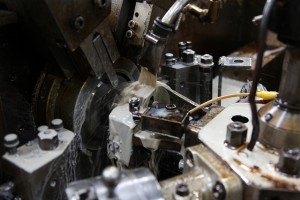 Temperature plays a critical role in lubrication performance. According to the Arrhenius Rate Rule, lubricants will degrade (oxidize) twice as fast for every 18°F increase over base temperature. Lackluster performance is often the result of poor lubrication maintenance or storage. Without properly performing lubricant, machines are much more likely to lock up, resulting in expensive downtime and repairs. As such, neglected lubricant spikes operation costs, as it will tend to break down more quickly.
Temperature plays a critical role in lubrication performance. According to the Arrhenius Rate Rule, lubricants will degrade (oxidize) twice as fast for every 18°F increase over base temperature. Lackluster performance is often the result of poor lubrication maintenance or storage. Without properly performing lubricant, machines are much more likely to lock up, resulting in expensive downtime and repairs. As such, neglected lubricant spikes operation costs, as it will tend to break down more quickly.
Lubricant Storage & Maintenance Problems & Solutions
Lubrication Problem #1: Heat Generated from Machinery Friction.
The goal with any lubricant is to maintain a consistent oil film between two surfaces, such as a shaft and a bearing. The film keeps everything operating smoothly and minimizes wear and tear. During operation, some oil molecules will be drawn to the shaft, while others are attracted to the bearing. At normal temperatures, this is no problem because the oil’s viscosity preserves an intervening oil film. However, excessive operating temperatures can cause a higher shear state—meaning molecules are drawn to the two surfaces more quickly. As the oil separates in this way, metal-to-metal contact becomes more likely. High operating temperatures can also cause the oil to oxidize. Oxidized oils have a lower viscosity and tend to leave behind more harmful deposits.
Solution: Select Falk lubricant carefully, and ensure operation temperatures do not exceed lubricant and machinery limits.
Lubrication Problem #2: Low Operating Temperatures.
Every lubricant has an ideal window of operating temperatures. Just as excessive heat can damage lubrication, so can cold temperatures. In too-cold conditions, viscosity spikes and the oil will eventually congeal then stop flowing altogether. Typically, oils are only subjected to frigid operating conditions when machinery is subjected to the external environment, such as in arctic or high-altitude locations. Serious problems can occur when lubrication flow rates fall; first, bearings, pumps and other parts may be torn apart without lubrication. In hydraulic lubrication systems, excessive oil viscosity causes air bubbles to be drawn into the pump, creating disruptive, loud noises and damage to internal parts. Additionally, filters may collapse under low-viscosity conditions.
Solution: Protect machinery from the elements, and select oil that maintains viscosity in your operating environment.
Because temperature plays such a key role in lubrication performance, it’s best to create Thermal Lubrication Charts (TLC) for important machines. A TLC will show several ranges – Zone 3, in the middle, will be the range of normal operation temperatures. Zones 2 and 4 should trigger heater and cooler alarms, to alert operators of sub optimal and potentially damaging conditions. Zones 1 and 5 encompass extreme temperatures, in which continued operation could result in sudden machine death. In Zone 1, the lowest end of the operation temperature range, the system could be starved of lubrication. In Zone 5, fire hazards and high-friction wear may occur.
Lubricant Problem #3: Improper Storage Conditions.
Because many operations go through large amounts of lubrication, it is common to maintain a backup supply on site. Inadequate storage procedures can damage lubrication and overall operations. Unprotected lubricant containers may be contaminated with dust and dirt. Contamination is problematic for lubricants. Any foreign particles will limit performance. Second, lubrication that stays in storage too long may exceed shelf life. Last but not least, improperly labeled lube containers can cause cross-contamination, which can have disastrous effects on FALK gearboxes.
Solution: Create an organized lubrication room with careful receiving and dispensing procedures.
With careful planning and oversight, technicians can ensure proper operating temperatures and lubrication storage processes, extending lube life while protecting machinery.
[Photo from kense via CC License 2.0]
Posted under Machinery Maintenance on Tuesday, May 26th, 2015
